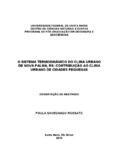| dc.creator | Rossato, Paula Savegnago | |
| dc.date.accessioned | 2010-07-21 | |
| dc.date.available | 2010-07-21 | |
| dc.date.issued | 2010-02-26 | |
| dc.identifier.citation | ROSSATO, Paula Savegnago. THE THERMODYNAMIC SYSTEM OF THE URBAN CLIMATE OF
NOVA PALMA, RS: CONTRIBUTION TO THE URBAN CLIMATE OF
SMALL CITIES.. 2010. 121 f. Dissertação (Mestrado em Geociências) - Universidade Federal de Santa Maria, Santa Maria, 2010. | por |
| dc.identifier.uri | http://repositorio.ufsm.br/handle/1/9318 | |
| dc.description.abstract | In recent years, people have been carried through small studies of urban climate focusing small and average cities, with intention to diagnosis and to prevent the
possible problems that these cities can come to face in the future to if becoming cities of bigger transport the study will be carried through in Nova Palma to verify
which is the configuration of some elements of the climate, as temperature of air, relative humidity of air and direction of the wind, in cities where the urban space is reduced. The city of Nova Palma presents a territorial extension of 362,48Km ² and population of 6.444 inhabitants, being who of these only 3Km ² are of urban area (headquarters), where inhabits 2,664 inhabitants. The research was made in accordance with the proposal of Monteiro (1976) to study the climate of a city, the
System Urban Climate, considered for this study the thermodynamic subsystem, that has as main elements the relative humidity of air, the temperature of air and the wind. Through points of comment installed in the interior of the city and its proximity, its had been collected the data of the main elements of the thermodynamic subsystem in
three schedules and for a period of 5 days consecutive in each one of the four seasons of the year of 2008. The area is understood here as proximity that is inside of the urban perimeter of Nova Palma, but that not yet it is urban. In the four stations of the year the thermodynamic elements if they had defined, firstly, for the sazonais
characteristics, after that for the operating atmospheric system and later for the geoecológicos and geourbanos condicionantes previously mentioned. It was also
observed, to if analyzing the data of the Station Meteorológica of Santa Maria, that Nova Palma always presented, in the days of referring collection to the four seasons of the year, minims of lesser temperatures, maximum greaters and raised relative humidity more registered than the values in the Station of the INMET (National Institute of Meteorologia). | eng |
| dc.format | application/pdf | por |
| dc.language | por | por |
| dc.publisher | Universidade Federal de Santa Maria | por |
| dc.rights | Acesso Aberto | por |
| dc.subject | Clima urbano | por |
| dc.subject | Temperatura | por |
| dc.subject | Sazonalidade | por |
| dc.subject | Urban climate | eng |
| dc.subject | Temperature | eng |
| dc.subject | Sazonalidade | eng |
| dc.title | O sistema termodinâmico do clima urbano de Nova
Palma, RS: contribuição ao clima urbano de cidades
pequenas | por |
| dc.title.alternative | The thermodynamic system of the urban climate of
Nova Palma, RS: contribution to the urban climate of
small cities. | eng |
| dc.type | Dissertação | por |
| dc.description.resumo | Nos últimos anos, tem-se realizado estudos de clima urbano enfocando pequenas e médias cidades, com o intuito de diagnosticar e prevenir os possíveis problemas que
as mesmas possam vir a enfrentar futuramente ao se tornarem cidades de porte maior. Esse estudo foi realizado em Nova Palma para se verificar quais são as características de alguns elementos do clima, como temperatura do ar, umidade
relativa do ar e direção do vento. O município de Nova Palma apresenta uma extensão territorial de 362,48Km² e população de 6.444 habitantes, sendo que destes apenas 3Km² são de área urbana (sede), onde residem 2.664 habitantes. A
pesquisa foi feita de acordo com a proposta de Monteiro (1976) para se estudar o clima de uma cidade, o Sistema Clima Urbano e considerou-se o subsistema termodinâmico, que tem como principais elementos a umidade relativa do ar, a
temperatura do ar e o vento. Através de pontos de observação instalados no interior da cidade e seu entorno, foram coletados os dados dos principais elementos do
subsistema termodinâmico em três horários e por um período de 5 dias consecutivos em cada uma das quatro estações do ano de 2008. Entende-se aqui como o entorno a área que está dentro do perímetro urbano de Nova Palma, mas que ainda não está urbanizada. Nas quatro estações do ano os elementos termodinâmicos se definiram, primeiramente, pelas características sazonais, em seguida pelo sistema atmosférico
atuante e depois, pelos condicionantes geoecológicos e geourbanos. Observou-se, também, ao se analisar os dados da Estação Meteorológica de Santa Maria, que Nova Palma sempre apresentou, nos dias de coleta referente às quatro estações do ano, mínimas de temperaturas menores, máximas maiores e umidade relativa mais elevada que os valores registrados na Estação do INMET (Instituto Nacional de
Meteorologia). | por |
| dc.contributor.advisor1 | Werlang, Mauro Kumpfer | |
| dc.contributor.advisor1Lattes | http://buscatextual.cnpq.br/buscatextual/visualizacv.do?id=K4785638D6 | por |
| dc.contributor.referee1 | Sartori, Maria da Graça Barros | |
| dc.contributor.referee1Lattes | http://buscatextual.cnpq.br/buscatextual/visualizacv.do?id=K4788074J5 | por |
| dc.contributor.referee2 | Nunes, Luci Hidalgo | |
| dc.contributor.referee2Lattes | http://buscatextual.cnpq.br/buscatextual/visualizacv.do?id=K4788555T6 | por |
| dc.creator.Lattes | http://buscatextual.cnpq.br/buscatextual/visualizacv.do?id=K4775120P5 | por |
| dc.publisher.country | BR | por |
| dc.publisher.department | Geociências | por |
| dc.publisher.initials | UFSM | por |
| dc.publisher.program | Programa de Pós-Graduação em Geografia e Geociências | por |
| dc.subject.cnpq | CNPQ::CIENCIAS EXATAS E DA TERRA::GEOCIENCIAS | por |


